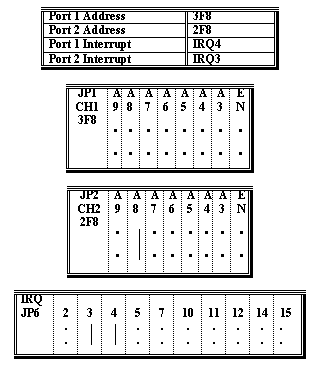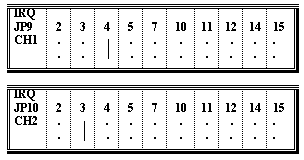CHAPTER 5
JUMPER SETTINGS
5.1 Introduction
The eleven jumper blocks on the
PCCOM ISA bus 2 port RS422/RS485
adapter must be configured correctly in accordance with the operating
system you are using.
JP1 (Jumper 1)
Determines the I/O address of the port 1.
JP2 (Jumper 2)
Determines the I/O address of the port 2.
JP3 (Jumper 3)
Select driver enable mode of channel 1.
JP4 (Jumper 4)
Select receiver enable mode of channel 1.
JP5 (Jumper 5)
Select high speed mode or normal speed mode.
JP6 (Jumper 6)
JP7 (Jumper 7)
Select driver enable mode of channel 2.
JP8 (Jumper 8)
Select receiver enable mode of channel 2.
JP9 (Jumper 9)
Select interrupt for port 1. The range is from IRQ2 to IRQ15.
JP10 (Jumper 10)
Select interrupt for port 2. The range is from IRQ2 to IRQ15.
JP11 (Jumper 11)
Select number of delay wait states.
Determines the I/O address of the port 1.
JP2 (Jumper 2)
Determines the I/O address of the port 2.
JP3 (Jumper 3)
Select driver enable mode of channel 1.
JP4 (Jumper 4)
Select receiver enable mode of channel 1.
JP5 (Jumper 5)
Select high speed mode or normal speed mode.
JP6 (Jumper 6)
Enable selected interrupt. The
selection of this jumper should
correspond to the selection of JP9 and JP10.
JP7 (Jumper 7)
Select driver enable mode of channel 2.
JP8 (Jumper 8)
Select receiver enable mode of channel 2.
JP9 (Jumper 9)
Select interrupt for port 1. The range is from IRQ2 to IRQ15.
JP10 (Jumper 10)
Select interrupt for port 2. The range is from IRQ2 to IRQ15.
JP11 (Jumper 11)
Select number of delay wait states.
5.2 Configuration for Jumper
It is important to refer to the
user manual supplied with your
operating system to determine the correct configuration. Although we
provide installation advice for various operating systems, it is not
possible to cover all systems in this user guide. Please contact your
supplier if you have any difficulties with configuration.
IMPORTANT: CARE MUST BE TAKEN
IN SELECTING THE
CONFIGURATION OF JUMPERS TO ENSURE YOU DO NOT DUPLICATE SETTINGS OF
OTHER EQUIPMENT ALREADY INSTALLED IN YOUR COMPUTER. DUPLICATION OF
SETTINGS WILL RESULT IN A MALFUNCTION OF ONE OR BOTH DEVICES.
Please refer to the following
settings for each
jumper block. If you are installing more than one board, do not
duplicate jumper settings for any parameter.
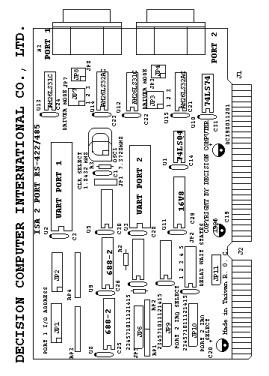
1. I/O Port Address
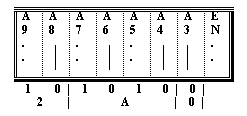
JP1 and JP2 are used to select
UART I/O address for each port. Where
JP1 is used to select port 1 address, JP2 is used to select port 2
address. Each JP contains A9 to A3 jumper pins and EN jumper pin.
The A9 to A3 are used to set I/O port address, when the corresponding
pin is short means 0, otherwise no pin short means 1. The figure
above set the I/O address to 2A0H. The EN pin is used to enable the
selected port, not short the jumper means enable the port, otherwise,
if short the jumper means disable this port.
The setting examples of this board are:
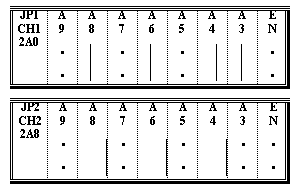

JP9 is used to select interrupt
for port 1 and JP10 is used to select
interrupt for port 2. It can arrange these interrupts in any
combination, this means it can set all ports in different interrupt,
however, do not share the same interrupt. The figures shown above is to
set interrupt on 5.
3. Common IRQ

The JP6 is used to enable IRQ2
to IRQ15 bus lines. Note that the
selection of this jumper should correspond to the selection of the
interrupts on the JP9 and JP10. For example, if you select IRQ5 and
IRQ10 on the JP9 and JP10, you need short IRQ5 and IRQ10 of JP6.
4. Select Wait State

The numbers of delay wait state are selected by JP11. Shorting position 1 means not wait CPU clock, shorting position 2 means wait 1 CPU clock, íK etc.
5. Select High Speed or Normal Speed Mode

The JP5 is used to select high
speed mode or normal speed mode, the
clock is 7.3728MHZ for high speed mode, and 1.8432MHZ for normal speed
mode. For high speed mode, the baud rate speed up to 460K.

6. Driver Mode Selection
JP3 and JP7 are used to select
driver enable modes of channel 1 and 2
respectively. There are three enable modes:
a. Always enable (for RS422)
This is required to set the always enable mode for RS422 applications.
b. Enabled by RTS signal (for RS485)
When the signal is 1, the
driver is enabled, otherwise when the signal
is 0, the driver is disabled. To turn on the driver for RTS, you only
need to output 3 to the address of base address plus 4. To turn off the
drivers for RTS, you need to output 0 to the address of base address
plus 4.
c. Enabled by bit 0 (LSB) of control register (for RS485)
The address of the control register is base address plus 7. When the bit is set to 1, it enables the driver, otherwise when the bit is set to 0, it turns off the driver.
The driver mode selection of channel 1 is shown below:

Short JP3-1: driver always
enabled.
Short JP3-2: enabled by RTS.
Short JP3-3: enabled by bit 0 of control register.
Short JP3-2: enabled by RTS.
Short JP3-3: enabled by bit 0 of control register.
The driver mode selection of channel 2 is shown below:

Short JP7-1: driver always
enabled.
Short JP7-2: enabled by RTS.
Short JP7-3: enabled by bit 0 of control register.
Short JP7-2: enabled by RTS.
Short JP7-3: enabled by bit 0 of control register.
7. Receiver Mode Selection
JP4 and JP8 are used to select
the receiver enable mode of channel 1
and 2 respectively. There are two enable modes:
a. Always enable (for RS422)
For RS422 applications, setting to always enable is required.
b. Enabled by bit 1 (LSB) of control register (for RS485)
The address of control register
is base address plus 7. When the bit is
set to 1, the receiver is enabled, otherwise when the bit is set to 0,
the receiver is turned off.
The receiver mode selection of channel 1 is shown below.

Short JP4-1: receiver always
enable.
Short JP4-2: enabled by bit 1 of control register.
Short JP4-2: enabled by bit 1 of control register.
The receiver mode selection of channel 2 is shown below:

Short JP8-1: receiver always
enable.
Short JP8-2: enabled by bit 1 of control register.
Short JP8-2: enabled by bit 1 of control register.
5.3 RS422 Mode

You can set (JP3,JP4) and
(JP7,JP8) of this board to RS422 mode, then
use PCCOM device driver and utilities in different operating systems.
The PCCOM software provides device driver for different operating systems under RS422 mode, please refer APPENDIX.
5.4 RS485 Mode
You can set (JP3,JP4) and
(JP7,JP8) by yourself to control the driver
mode and receiver mode (you can select enabled by RTS signal or enabled
by control register pin). In this mode, you must control driver and
receiver by your application software.
To write your own driver, please refer Chapter 7.
5.5 Standard COM1 and COM2 ports
If you want to set the adapter as standard COM1 and COM2, please refer the following settings.
